Financial Ratio Analysis of Canadian Banks
VerifiedAdded on 2020/04/13
|16
|3546
|329
AI Summary
This assignment analyzes the financial health of three major Canadian banks: Royal Bank of Canada (RBC), Toronto Dominion Bank (TD), and Canadian Imperial Bank of Commerce (CIBC). It compares their key financial ratios, including solvency, liquidity, and profitability, over a period of time. The analysis uses ratios like debt-to-equity, financial leverage ratio, and asset turnover ratio to assess the banks' performance and stability. Additionally, the assignment calculates materiality thresholds based on net income for each bank.
Contribute Materials
Your contribution can guide someone’s learning journey. Share your
documents today.

Running head: AUDITING ANALYSIS
Auditing Analysis
Name of the Student:
Name of the University:
Author Note
Auditing Analysis
Name of the Student:
Name of the University:
Author Note
Secure Best Marks with AI Grader
Need help grading? Try our AI Grader for instant feedback on your assignments.

1AUDITING ANALYSIS
Table of Contents
Introduction................................................................................................................................3
Auditing Overview.................................................................................................................3
Quantitative Risk 1.....................................................................................................................4
Auditing Procedure................................................................................................................4
Management Assertion...........................................................................................................5
Quantitative Risk 2.....................................................................................................................6
Auditing procedure.................................................................................................................6
Management Assertion...........................................................................................................7
Quantitative Risk 3.....................................................................................................................7
Auditing procedure.................................................................................................................7
Management Assertion...........................................................................................................8
Qualitative Risk 1.......................................................................................................................9
Auditing Procedure................................................................................................................9
Management’s Assertion........................................................................................................9
Qualitative Risk 2.....................................................................................................................10
Auditing Procedure..............................................................................................................10
Management Assertion.........................................................................................................10
Conclusion................................................................................................................................10
References................................................................................................................................12
Appendix..................................................................................................................................14
Table of Contents
Introduction................................................................................................................................3
Auditing Overview.................................................................................................................3
Quantitative Risk 1.....................................................................................................................4
Auditing Procedure................................................................................................................4
Management Assertion...........................................................................................................5
Quantitative Risk 2.....................................................................................................................6
Auditing procedure.................................................................................................................6
Management Assertion...........................................................................................................7
Quantitative Risk 3.....................................................................................................................7
Auditing procedure.................................................................................................................7
Management Assertion...........................................................................................................8
Qualitative Risk 1.......................................................................................................................9
Auditing Procedure................................................................................................................9
Management’s Assertion........................................................................................................9
Qualitative Risk 2.....................................................................................................................10
Auditing Procedure..............................................................................................................10
Management Assertion.........................................................................................................10
Conclusion................................................................................................................................10
References................................................................................................................................12
Appendix..................................................................................................................................14
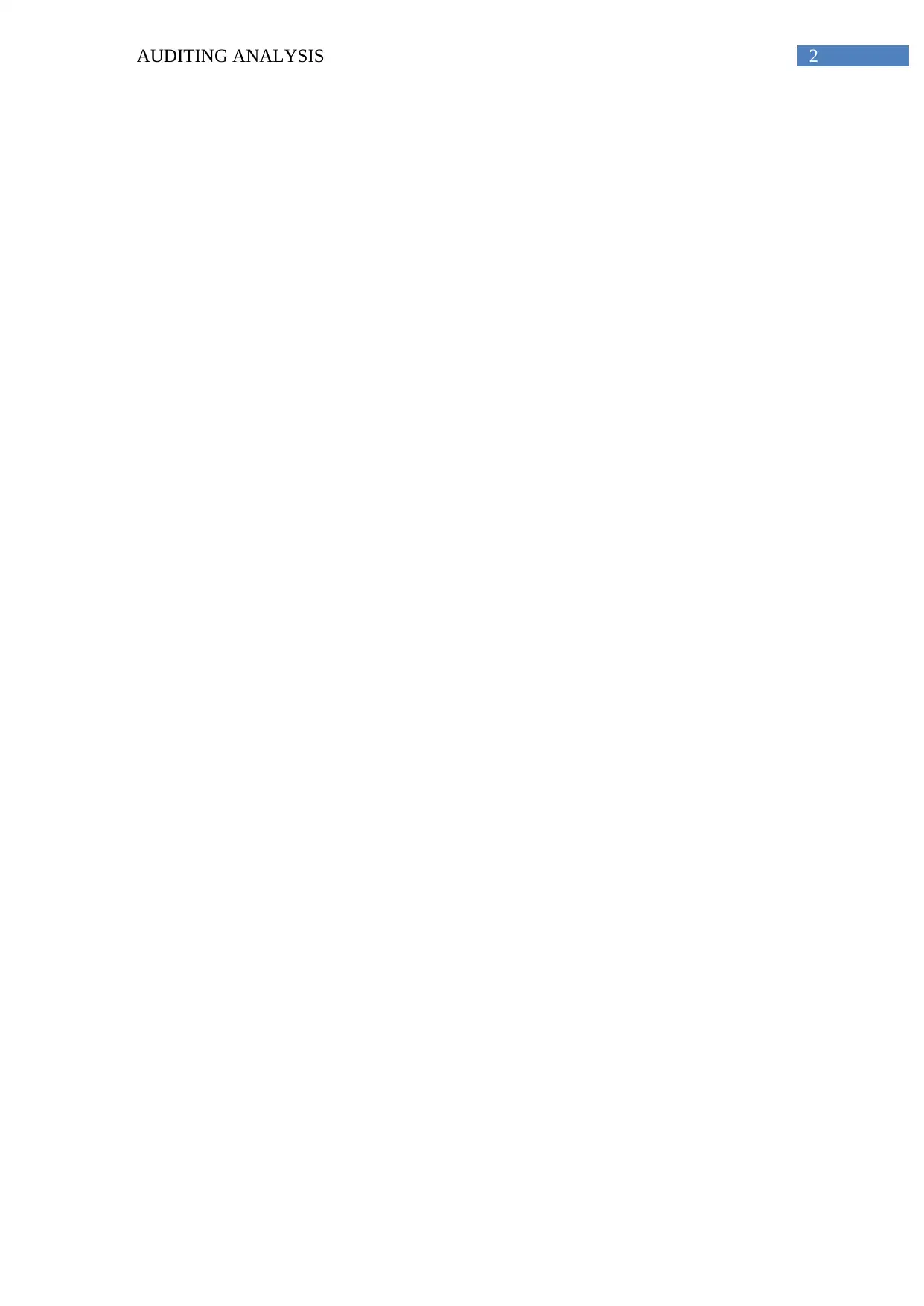
2AUDITING ANALYSIS
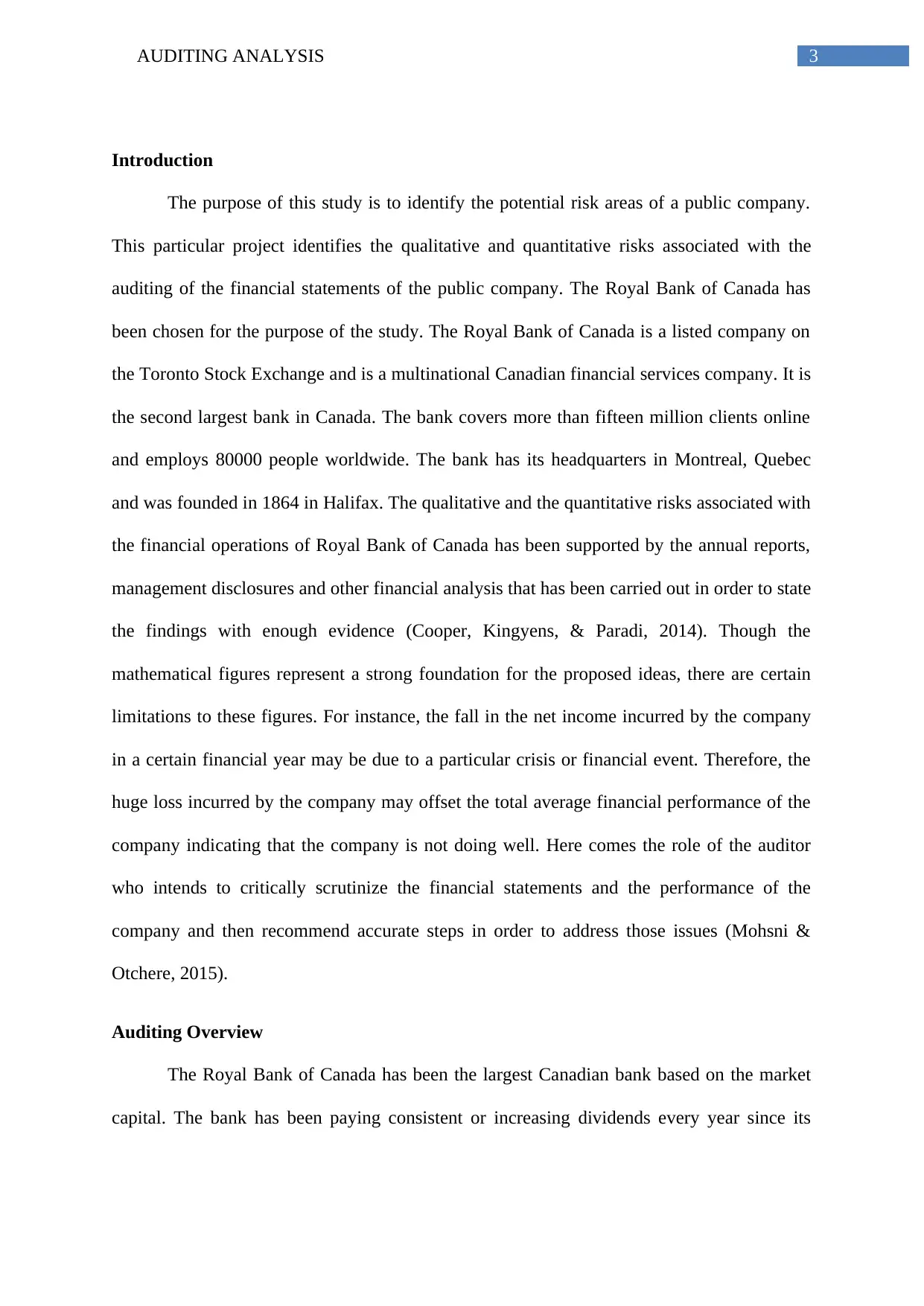
3AUDITING ANALYSIS
Introduction
The purpose of this study is to identify the potential risk areas of a public company.
This particular project identifies the qualitative and quantitative risks associated with the
auditing of the financial statements of the public company. The Royal Bank of Canada has
been chosen for the purpose of the study. The Royal Bank of Canada is a listed company on
the Toronto Stock Exchange and is a multinational Canadian financial services company. It is
the second largest bank in Canada. The bank covers more than fifteen million clients online
and employs 80000 people worldwide. The bank has its headquarters in Montreal, Quebec
and was founded in 1864 in Halifax. The qualitative and the quantitative risks associated with
the financial operations of Royal Bank of Canada has been supported by the annual reports,
management disclosures and other financial analysis that has been carried out in order to state
the findings with enough evidence (Cooper, Kingyens, & Paradi, 2014). Though the
mathematical figures represent a strong foundation for the proposed ideas, there are certain
limitations to these figures. For instance, the fall in the net income incurred by the company
in a certain financial year may be due to a particular crisis or financial event. Therefore, the
huge loss incurred by the company may offset the total average financial performance of the
company indicating that the company is not doing well. Here comes the role of the auditor
who intends to critically scrutinize the financial statements and the performance of the
company and then recommend accurate steps in order to address those issues (Mohsni &
Otchere, 2015).
Auditing Overview
The Royal Bank of Canada has been the largest Canadian bank based on the market
capital. The bank has been paying consistent or increasing dividends every year since its
Introduction
The purpose of this study is to identify the potential risk areas of a public company.
This particular project identifies the qualitative and quantitative risks associated with the
auditing of the financial statements of the public company. The Royal Bank of Canada has
been chosen for the purpose of the study. The Royal Bank of Canada is a listed company on
the Toronto Stock Exchange and is a multinational Canadian financial services company. It is
the second largest bank in Canada. The bank covers more than fifteen million clients online
and employs 80000 people worldwide. The bank has its headquarters in Montreal, Quebec
and was founded in 1864 in Halifax. The qualitative and the quantitative risks associated with
the financial operations of Royal Bank of Canada has been supported by the annual reports,
management disclosures and other financial analysis that has been carried out in order to state
the findings with enough evidence (Cooper, Kingyens, & Paradi, 2014). Though the
mathematical figures represent a strong foundation for the proposed ideas, there are certain
limitations to these figures. For instance, the fall in the net income incurred by the company
in a certain financial year may be due to a particular crisis or financial event. Therefore, the
huge loss incurred by the company may offset the total average financial performance of the
company indicating that the company is not doing well. Here comes the role of the auditor
who intends to critically scrutinize the financial statements and the performance of the
company and then recommend accurate steps in order to address those issues (Mohsni &
Otchere, 2015).
Auditing Overview
The Royal Bank of Canada has been the largest Canadian bank based on the market
capital. The bank has been paying consistent or increasing dividends every year since its
Secure Best Marks with AI Grader
Need help grading? Try our AI Grader for instant feedback on your assignments.
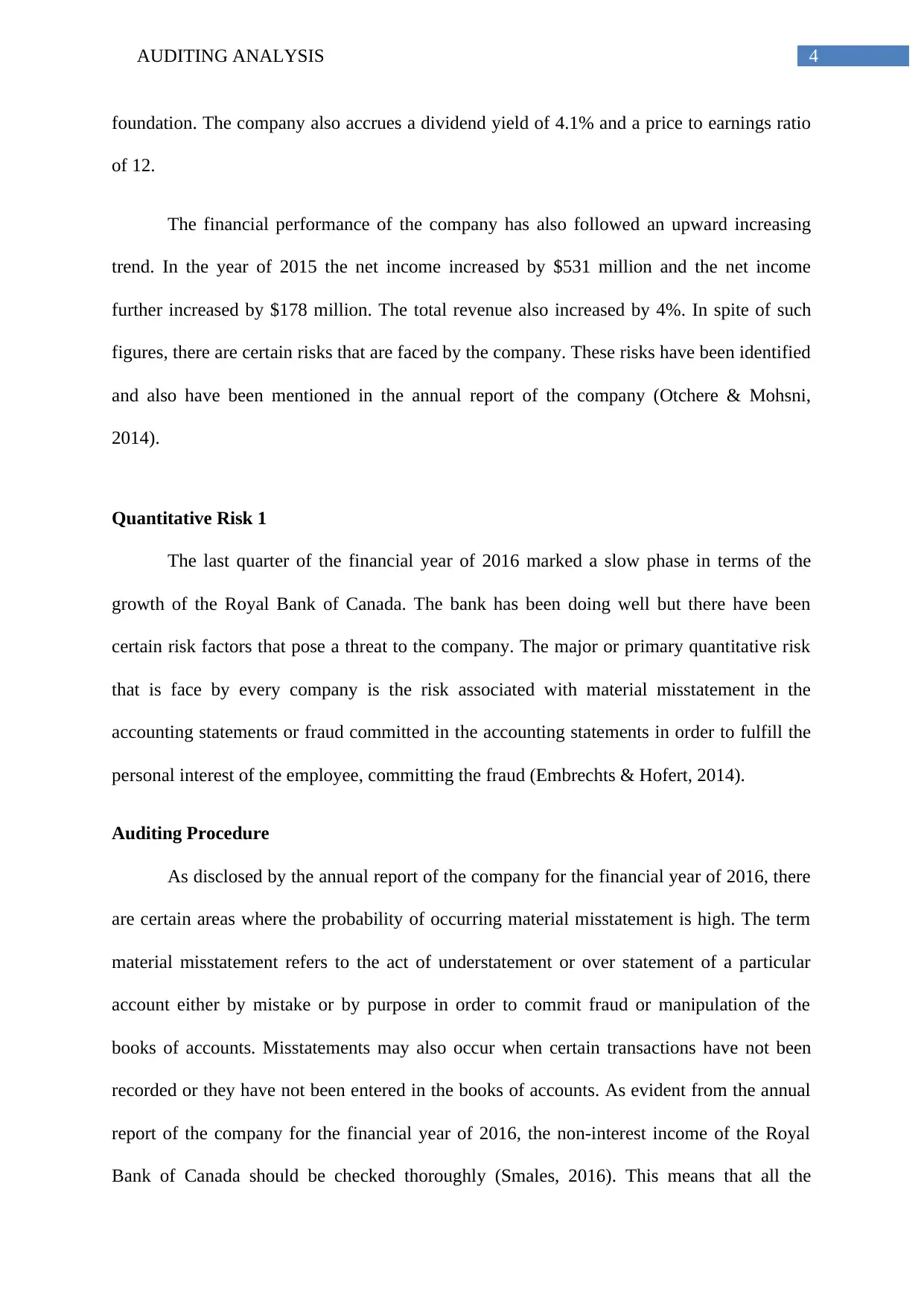
4AUDITING ANALYSIS
foundation. The company also accrues a dividend yield of 4.1% and a price to earnings ratio
of 12.
The financial performance of the company has also followed an upward increasing
trend. In the year of 2015 the net income increased by $531 million and the net income
further increased by $178 million. The total revenue also increased by 4%. In spite of such
figures, there are certain risks that are faced by the company. These risks have been identified
and also have been mentioned in the annual report of the company (Otchere & Mohsni,
2014).
Quantitative Risk 1
The last quarter of the financial year of 2016 marked a slow phase in terms of the
growth of the Royal Bank of Canada. The bank has been doing well but there have been
certain risk factors that pose a threat to the company. The major or primary quantitative risk
that is face by every company is the risk associated with material misstatement in the
accounting statements or fraud committed in the accounting statements in order to fulfill the
personal interest of the employee, committing the fraud (Embrechts & Hofert, 2014).
Auditing Procedure
As disclosed by the annual report of the company for the financial year of 2016, there
are certain areas where the probability of occurring material misstatement is high. The term
material misstatement refers to the act of understatement or over statement of a particular
account either by mistake or by purpose in order to commit fraud or manipulation of the
books of accounts. Misstatements may also occur when certain transactions have not been
recorded or they have not been entered in the books of accounts. As evident from the annual
report of the company for the financial year of 2016, the non-interest income of the Royal
Bank of Canada should be checked thoroughly (Smales, 2016). This means that all the
foundation. The company also accrues a dividend yield of 4.1% and a price to earnings ratio
of 12.
The financial performance of the company has also followed an upward increasing
trend. In the year of 2015 the net income increased by $531 million and the net income
further increased by $178 million. The total revenue also increased by 4%. In spite of such
figures, there are certain risks that are faced by the company. These risks have been identified
and also have been mentioned in the annual report of the company (Otchere & Mohsni,
2014).
Quantitative Risk 1
The last quarter of the financial year of 2016 marked a slow phase in terms of the
growth of the Royal Bank of Canada. The bank has been doing well but there have been
certain risk factors that pose a threat to the company. The major or primary quantitative risk
that is face by every company is the risk associated with material misstatement in the
accounting statements or fraud committed in the accounting statements in order to fulfill the
personal interest of the employee, committing the fraud (Embrechts & Hofert, 2014).
Auditing Procedure
As disclosed by the annual report of the company for the financial year of 2016, there
are certain areas where the probability of occurring material misstatement is high. The term
material misstatement refers to the act of understatement or over statement of a particular
account either by mistake or by purpose in order to commit fraud or manipulation of the
books of accounts. Misstatements may also occur when certain transactions have not been
recorded or they have not been entered in the books of accounts. As evident from the annual
report of the company for the financial year of 2016, the non-interest income of the Royal
Bank of Canada should be checked thoroughly (Smales, 2016). This means that all the
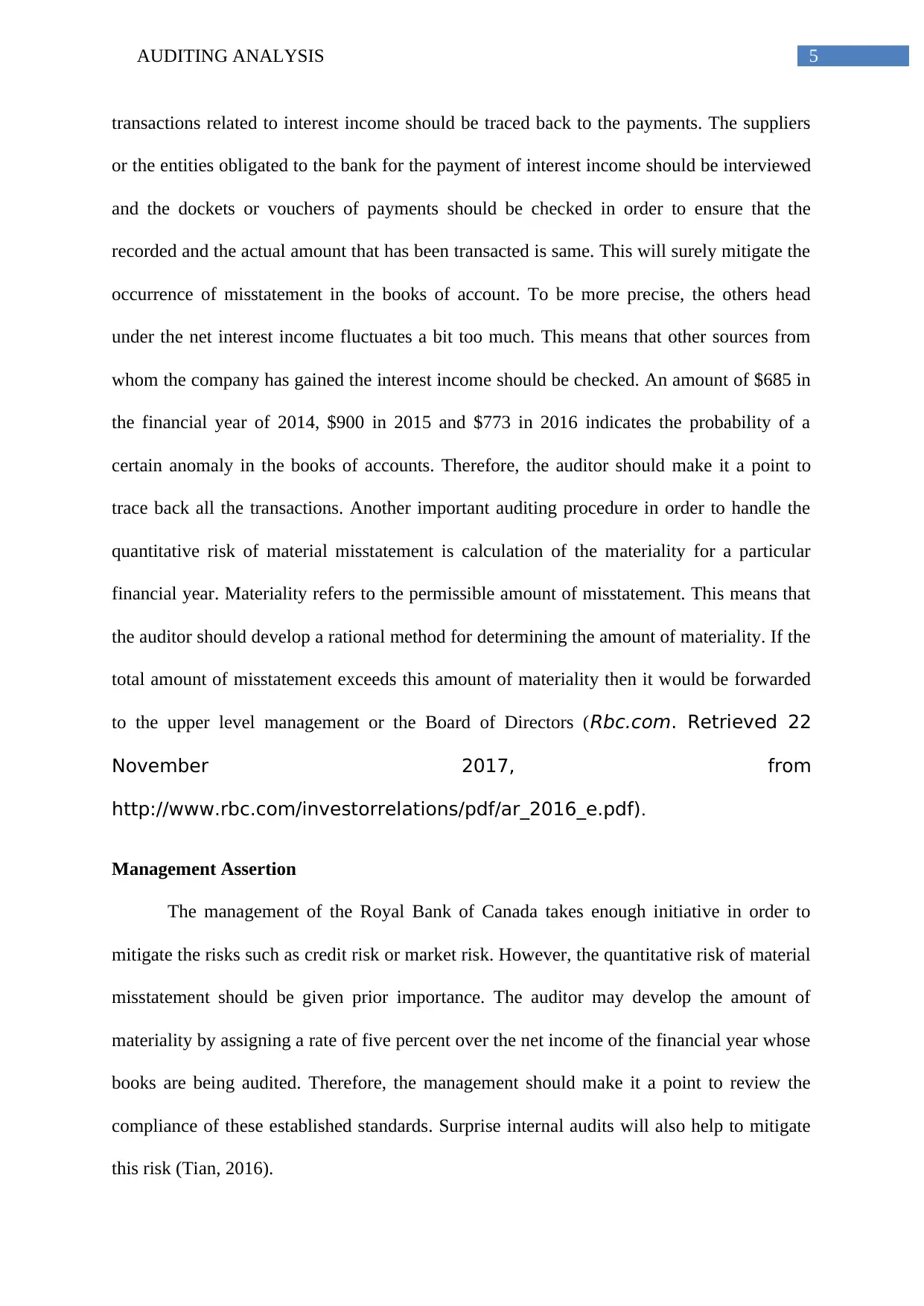
5AUDITING ANALYSIS
transactions related to interest income should be traced back to the payments. The suppliers
or the entities obligated to the bank for the payment of interest income should be interviewed
and the dockets or vouchers of payments should be checked in order to ensure that the
recorded and the actual amount that has been transacted is same. This will surely mitigate the
occurrence of misstatement in the books of account. To be more precise, the others head
under the net interest income fluctuates a bit too much. This means that other sources from
whom the company has gained the interest income should be checked. An amount of $685 in
the financial year of 2014, $900 in 2015 and $773 in 2016 indicates the probability of a
certain anomaly in the books of accounts. Therefore, the auditor should make it a point to
trace back all the transactions. Another important auditing procedure in order to handle the
quantitative risk of material misstatement is calculation of the materiality for a particular
financial year. Materiality refers to the permissible amount of misstatement. This means that
the auditor should develop a rational method for determining the amount of materiality. If the
total amount of misstatement exceeds this amount of materiality then it would be forwarded
to the upper level management or the Board of Directors (Rbc.com. Retrieved 22
November 2017, from
http://www.rbc.com/investorrelations/pdf/ar_2016_e.pdf).
Management Assertion
The management of the Royal Bank of Canada takes enough initiative in order to
mitigate the risks such as credit risk or market risk. However, the quantitative risk of material
misstatement should be given prior importance. The auditor may develop the amount of
materiality by assigning a rate of five percent over the net income of the financial year whose
books are being audited. Therefore, the management should make it a point to review the
compliance of these established standards. Surprise internal audits will also help to mitigate
this risk (Tian, 2016).
transactions related to interest income should be traced back to the payments. The suppliers
or the entities obligated to the bank for the payment of interest income should be interviewed
and the dockets or vouchers of payments should be checked in order to ensure that the
recorded and the actual amount that has been transacted is same. This will surely mitigate the
occurrence of misstatement in the books of account. To be more precise, the others head
under the net interest income fluctuates a bit too much. This means that other sources from
whom the company has gained the interest income should be checked. An amount of $685 in
the financial year of 2014, $900 in 2015 and $773 in 2016 indicates the probability of a
certain anomaly in the books of accounts. Therefore, the auditor should make it a point to
trace back all the transactions. Another important auditing procedure in order to handle the
quantitative risk of material misstatement is calculation of the materiality for a particular
financial year. Materiality refers to the permissible amount of misstatement. This means that
the auditor should develop a rational method for determining the amount of materiality. If the
total amount of misstatement exceeds this amount of materiality then it would be forwarded
to the upper level management or the Board of Directors (Rbc.com. Retrieved 22
November 2017, from
http://www.rbc.com/investorrelations/pdf/ar_2016_e.pdf).
Management Assertion
The management of the Royal Bank of Canada takes enough initiative in order to
mitigate the risks such as credit risk or market risk. However, the quantitative risk of material
misstatement should be given prior importance. The auditor may develop the amount of
materiality by assigning a rate of five percent over the net income of the financial year whose
books are being audited. Therefore, the management should make it a point to review the
compliance of these established standards. Surprise internal audits will also help to mitigate
this risk (Tian, 2016).

6AUDITING ANALYSIS
Quantitative Risk 2
The next potential quantitative risk that the Royal Bank of Canada is facing is the
imminent threat of cyber risk. The security related to information and other important data in
the financial services sector should be high. With the technological leap that the entire
banking sector has undertaken the protection of client and other relevant data has become
highly important. Recent instances of cyber attacks have proved that the financial sectors or
the IT departments of the respective organizations are not competent enough to save the
crucial organization information from the hackers (McNeil, Frey & Embrechts, 2015).
Auditing procedure
The potential intangible assets that are affected by these cyber attacks are financial
data, client information, goodwill of the company, trade secrets and other software related
data. The Royal Bank of Canada has been facing this threat. This is requires a quantitative
analysis as because this particular risk cannot be mitigated without assigning proper valuation
to the assets under threat. The auditor must find out the value of these intangible assets with
the help of the fair market valuation system (Cohen, Krishnamoorthy & Wright, 2017). The
auditor may utilize the cost approach or the income approach in order to find out the value of
these intellectual assets. Thus after the valuation of the intangible assets the growth or
deterioration of these assets can be measured. This can clearly indicate the effect and result of
the cyber attacks or other security threats that is faced by the Royal Bank of Canada. The
particular question that the auditing team needs to ask the management of the Royal Bank of
Canada is that whether they have been taking proper initiative in order to maintain the
informational or client security of the bank. There should be proper application of passwords
and portal codes with restricted access in order to maintain the privacy. Competent backing
up processes and storage devices with enough protection should be available. Moreover, the
backing up of files containing important information should be made a periodic activity by
Quantitative Risk 2
The next potential quantitative risk that the Royal Bank of Canada is facing is the
imminent threat of cyber risk. The security related to information and other important data in
the financial services sector should be high. With the technological leap that the entire
banking sector has undertaken the protection of client and other relevant data has become
highly important. Recent instances of cyber attacks have proved that the financial sectors or
the IT departments of the respective organizations are not competent enough to save the
crucial organization information from the hackers (McNeil, Frey & Embrechts, 2015).
Auditing procedure
The potential intangible assets that are affected by these cyber attacks are financial
data, client information, goodwill of the company, trade secrets and other software related
data. The Royal Bank of Canada has been facing this threat. This is requires a quantitative
analysis as because this particular risk cannot be mitigated without assigning proper valuation
to the assets under threat. The auditor must find out the value of these intangible assets with
the help of the fair market valuation system (Cohen, Krishnamoorthy & Wright, 2017). The
auditor may utilize the cost approach or the income approach in order to find out the value of
these intellectual assets. Thus after the valuation of the intangible assets the growth or
deterioration of these assets can be measured. This can clearly indicate the effect and result of
the cyber attacks or other security threats that is faced by the Royal Bank of Canada. The
particular question that the auditing team needs to ask the management of the Royal Bank of
Canada is that whether they have been taking proper initiative in order to maintain the
informational or client security of the bank. There should be proper application of passwords
and portal codes with restricted access in order to maintain the privacy. Competent backing
up processes and storage devices with enough protection should be available. Moreover, the
backing up of files containing important information should be made a periodic activity by
Paraphrase This Document
Need a fresh take? Get an instant paraphrase of this document with our AI Paraphraser
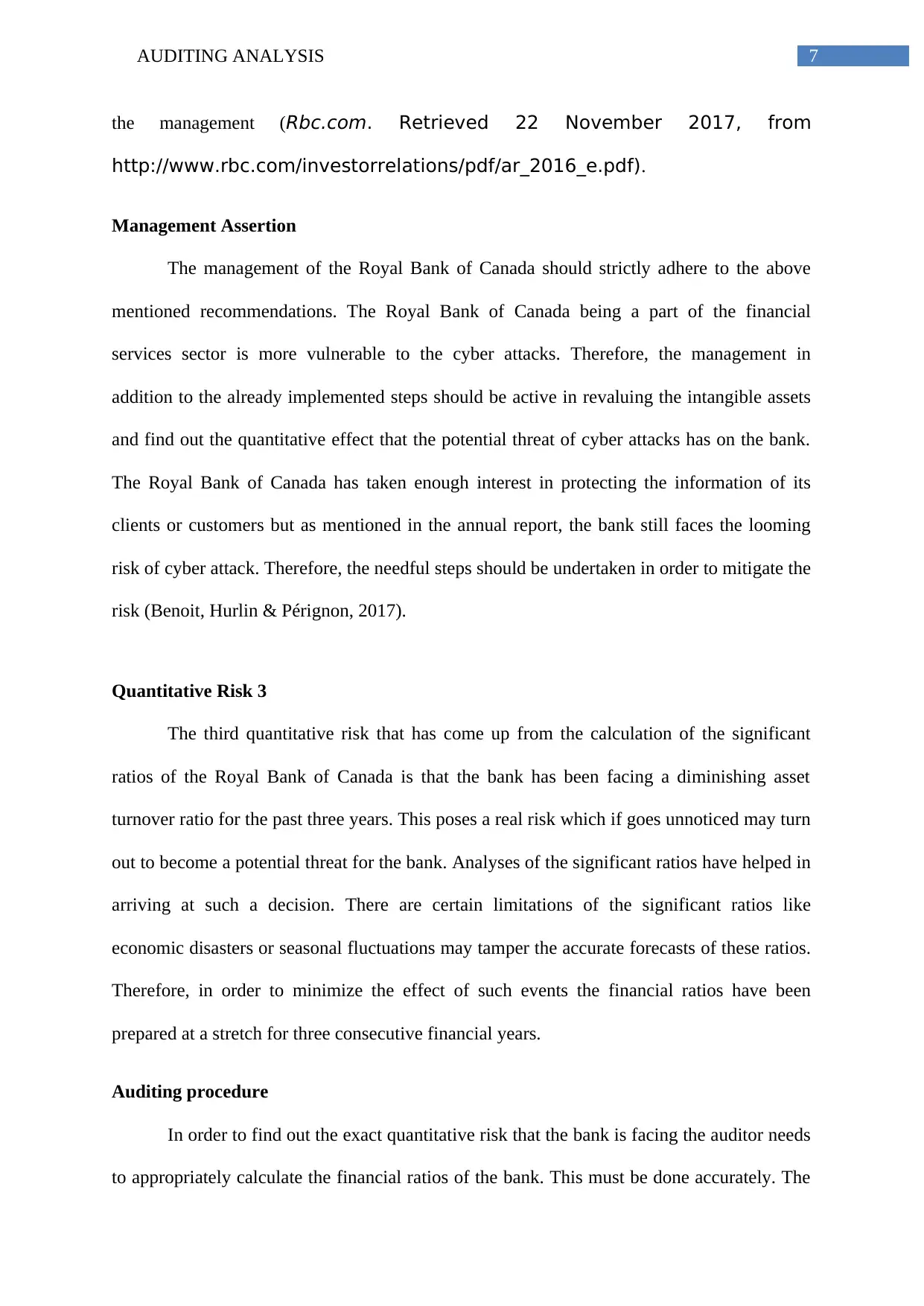
7AUDITING ANALYSIS
the management (Rbc.com. Retrieved 22 November 2017, from
http://www.rbc.com/investorrelations/pdf/ar_2016_e.pdf).
Management Assertion
The management of the Royal Bank of Canada should strictly adhere to the above
mentioned recommendations. The Royal Bank of Canada being a part of the financial
services sector is more vulnerable to the cyber attacks. Therefore, the management in
addition to the already implemented steps should be active in revaluing the intangible assets
and find out the quantitative effect that the potential threat of cyber attacks has on the bank.
The Royal Bank of Canada has taken enough interest in protecting the information of its
clients or customers but as mentioned in the annual report, the bank still faces the looming
risk of cyber attack. Therefore, the needful steps should be undertaken in order to mitigate the
risk (Benoit, Hurlin & Pérignon, 2017).
Quantitative Risk 3
The third quantitative risk that has come up from the calculation of the significant
ratios of the Royal Bank of Canada is that the bank has been facing a diminishing asset
turnover ratio for the past three years. This poses a real risk which if goes unnoticed may turn
out to become a potential threat for the bank. Analyses of the significant ratios have helped in
arriving at such a decision. There are certain limitations of the significant ratios like
economic disasters or seasonal fluctuations may tamper the accurate forecasts of these ratios.
Therefore, in order to minimize the effect of such events the financial ratios have been
prepared at a stretch for three consecutive financial years.
Auditing procedure
In order to find out the exact quantitative risk that the bank is facing the auditor needs
to appropriately calculate the financial ratios of the bank. This must be done accurately. The
the management (Rbc.com. Retrieved 22 November 2017, from
http://www.rbc.com/investorrelations/pdf/ar_2016_e.pdf).
Management Assertion
The management of the Royal Bank of Canada should strictly adhere to the above
mentioned recommendations. The Royal Bank of Canada being a part of the financial
services sector is more vulnerable to the cyber attacks. Therefore, the management in
addition to the already implemented steps should be active in revaluing the intangible assets
and find out the quantitative effect that the potential threat of cyber attacks has on the bank.
The Royal Bank of Canada has taken enough interest in protecting the information of its
clients or customers but as mentioned in the annual report, the bank still faces the looming
risk of cyber attack. Therefore, the needful steps should be undertaken in order to mitigate the
risk (Benoit, Hurlin & Pérignon, 2017).
Quantitative Risk 3
The third quantitative risk that has come up from the calculation of the significant
ratios of the Royal Bank of Canada is that the bank has been facing a diminishing asset
turnover ratio for the past three years. This poses a real risk which if goes unnoticed may turn
out to become a potential threat for the bank. Analyses of the significant ratios have helped in
arriving at such a decision. There are certain limitations of the significant ratios like
economic disasters or seasonal fluctuations may tamper the accurate forecasts of these ratios.
Therefore, in order to minimize the effect of such events the financial ratios have been
prepared at a stretch for three consecutive financial years.
Auditing procedure
In order to find out the exact quantitative risk that the bank is facing the auditor needs
to appropriately calculate the financial ratios of the bank. This must be done accurately. The

8AUDITING ANALYSIS
auditor must make sure that the figures obtained for the calculation of the financial ratios are
authentic and genuine, that is, they have been traced back to point of generation and has been
matched with the figures that have been recorded in the financial statements. Now, the asset
turnover ratio of the Royal Bank of Canada shows a diminishing figure in the current
financial year of 2016 that is 0.03. The bank has been maintaining a stable asset turnover
ratio of 0.04 for the past few financial years. But the current year of 2016 show a drop in
asset turnover ratio. Now the asset turnover ratio refers to the ability of an organization to
utilize its assets in order to generate revenue. The more efficiently an organization deploys its
assets in the generation of company revenue, the more is the asset turnover ratio. This
particular ratio being constant may also be a reason of concern for the bank. A constant ratio
poses that the bank is not being able to improve the efficiency of its assets for increasing the
revenue generation incurred by the bank (Chu, 2015). The question that the auditor should
ask the management is that what internal controls have been implemented in order to increase
the efficiency of the utilization of the assets. The potential procedures that might be adopted
by the bank in order to increase its asset turnover ratio is that the bank may look after the
collections from its debtors, that is, increase in the collections or the accounts receivables will
increase the asset turnover ratio. More importantly, increase in efficiency of utilization of the
assets of the bank and implementation of technology in order to properly record the internal
proceeding would help to increase the asset turnover ratio of the Royal Bank of Canada
(Rbc.com. Retrieved 22 November 2017, from
http://www.rbc.com/investorrelations/pdf/ar_2016_e.pdf)..
Management Assertion
The management of the Royal Bank of Canada has implemented enough measures to
overcome the credit risks. However, the consistent asset turnover ratio should have been a
reason of concern. In addition to it the current value of the ratio has dropped, the management
auditor must make sure that the figures obtained for the calculation of the financial ratios are
authentic and genuine, that is, they have been traced back to point of generation and has been
matched with the figures that have been recorded in the financial statements. Now, the asset
turnover ratio of the Royal Bank of Canada shows a diminishing figure in the current
financial year of 2016 that is 0.03. The bank has been maintaining a stable asset turnover
ratio of 0.04 for the past few financial years. But the current year of 2016 show a drop in
asset turnover ratio. Now the asset turnover ratio refers to the ability of an organization to
utilize its assets in order to generate revenue. The more efficiently an organization deploys its
assets in the generation of company revenue, the more is the asset turnover ratio. This
particular ratio being constant may also be a reason of concern for the bank. A constant ratio
poses that the bank is not being able to improve the efficiency of its assets for increasing the
revenue generation incurred by the bank (Chu, 2015). The question that the auditor should
ask the management is that what internal controls have been implemented in order to increase
the efficiency of the utilization of the assets. The potential procedures that might be adopted
by the bank in order to increase its asset turnover ratio is that the bank may look after the
collections from its debtors, that is, increase in the collections or the accounts receivables will
increase the asset turnover ratio. More importantly, increase in efficiency of utilization of the
assets of the bank and implementation of technology in order to properly record the internal
proceeding would help to increase the asset turnover ratio of the Royal Bank of Canada
(Rbc.com. Retrieved 22 November 2017, from
http://www.rbc.com/investorrelations/pdf/ar_2016_e.pdf)..
Management Assertion
The management of the Royal Bank of Canada has implemented enough measures to
overcome the credit risks. However, the consistent asset turnover ratio should have been a
reason of concern. In addition to it the current value of the ratio has dropped, the management
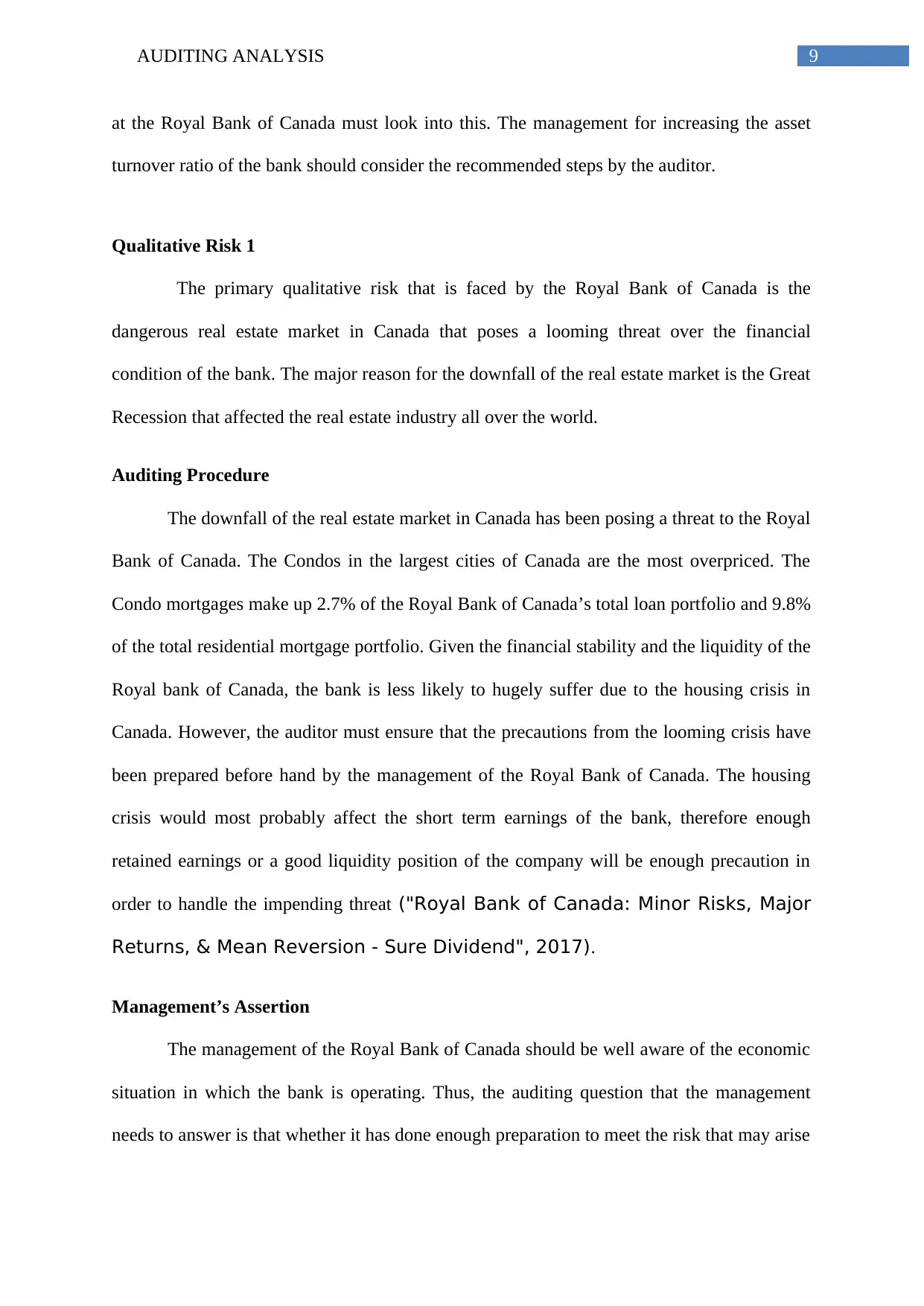
9AUDITING ANALYSIS
at the Royal Bank of Canada must look into this. The management for increasing the asset
turnover ratio of the bank should consider the recommended steps by the auditor.
Qualitative Risk 1
The primary qualitative risk that is faced by the Royal Bank of Canada is the
dangerous real estate market in Canada that poses a looming threat over the financial
condition of the bank. The major reason for the downfall of the real estate market is the Great
Recession that affected the real estate industry all over the world.
Auditing Procedure
The downfall of the real estate market in Canada has been posing a threat to the Royal
Bank of Canada. The Condos in the largest cities of Canada are the most overpriced. The
Condo mortgages make up 2.7% of the Royal Bank of Canada’s total loan portfolio and 9.8%
of the total residential mortgage portfolio. Given the financial stability and the liquidity of the
Royal bank of Canada, the bank is less likely to hugely suffer due to the housing crisis in
Canada. However, the auditor must ensure that the precautions from the looming crisis have
been prepared before hand by the management of the Royal Bank of Canada. The housing
crisis would most probably affect the short term earnings of the bank, therefore enough
retained earnings or a good liquidity position of the company will be enough precaution in
order to handle the impending threat ("Royal Bank of Canada: Minor Risks, Major
Returns, & Mean Reversion - Sure Dividend", 2017).
Management’s Assertion
The management of the Royal Bank of Canada should be well aware of the economic
situation in which the bank is operating. Thus, the auditing question that the management
needs to answer is that whether it has done enough preparation to meet the risk that may arise
at the Royal Bank of Canada must look into this. The management for increasing the asset
turnover ratio of the bank should consider the recommended steps by the auditor.
Qualitative Risk 1
The primary qualitative risk that is faced by the Royal Bank of Canada is the
dangerous real estate market in Canada that poses a looming threat over the financial
condition of the bank. The major reason for the downfall of the real estate market is the Great
Recession that affected the real estate industry all over the world.
Auditing Procedure
The downfall of the real estate market in Canada has been posing a threat to the Royal
Bank of Canada. The Condos in the largest cities of Canada are the most overpriced. The
Condo mortgages make up 2.7% of the Royal Bank of Canada’s total loan portfolio and 9.8%
of the total residential mortgage portfolio. Given the financial stability and the liquidity of the
Royal bank of Canada, the bank is less likely to hugely suffer due to the housing crisis in
Canada. However, the auditor must ensure that the precautions from the looming crisis have
been prepared before hand by the management of the Royal Bank of Canada. The housing
crisis would most probably affect the short term earnings of the bank, therefore enough
retained earnings or a good liquidity position of the company will be enough precaution in
order to handle the impending threat ("Royal Bank of Canada: Minor Risks, Major
Returns, & Mean Reversion - Sure Dividend", 2017).
Management’s Assertion
The management of the Royal Bank of Canada should be well aware of the economic
situation in which the bank is operating. Thus, the auditing question that the management
needs to answer is that whether it has done enough preparation to meet the risk that may arise
Secure Best Marks with AI Grader
Need help grading? Try our AI Grader for instant feedback on your assignments.
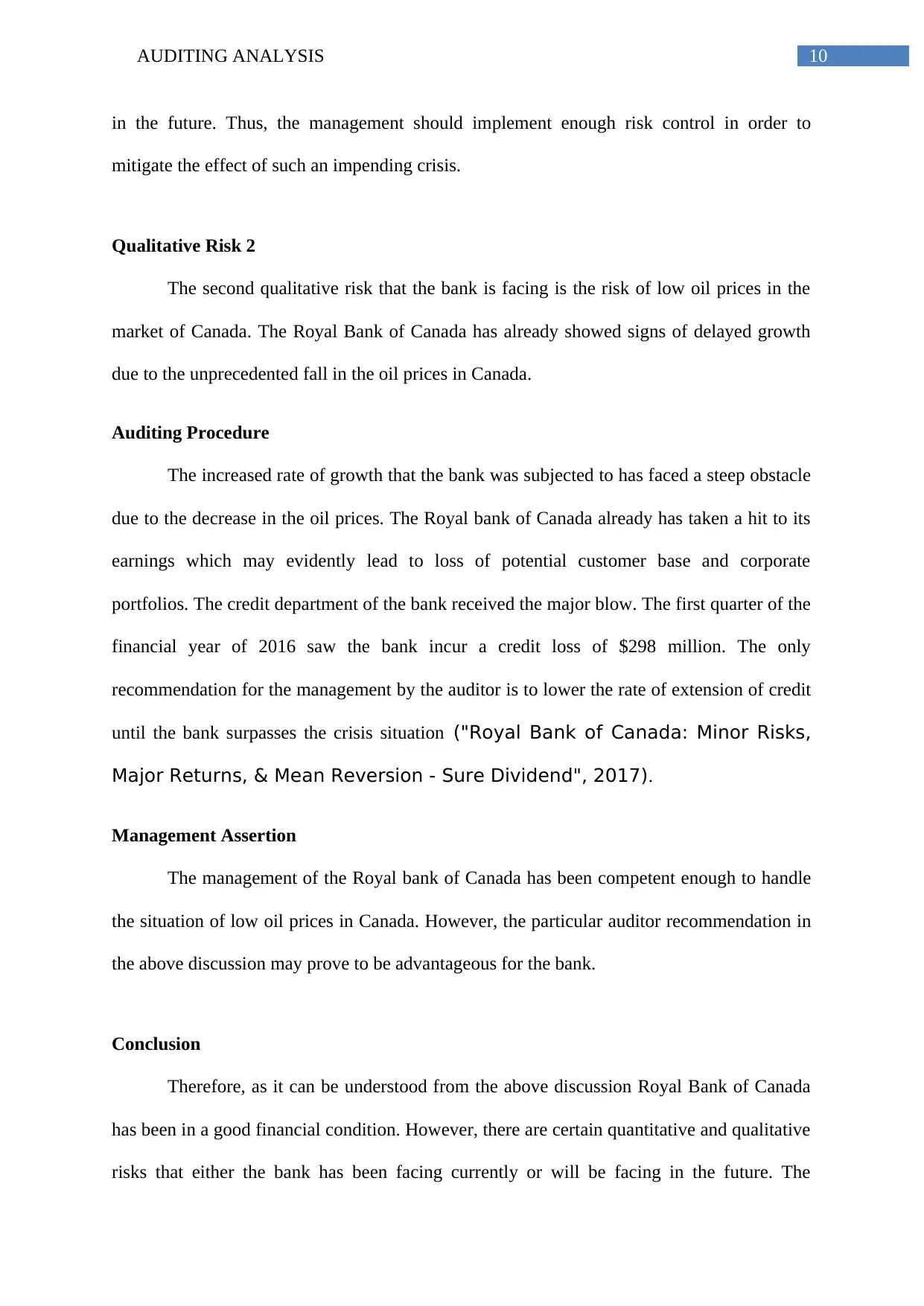
10AUDITING ANALYSIS
in the future. Thus, the management should implement enough risk control in order to
mitigate the effect of such an impending crisis.
Qualitative Risk 2
The second qualitative risk that the bank is facing is the risk of low oil prices in the
market of Canada. The Royal Bank of Canada has already showed signs of delayed growth
due to the unprecedented fall in the oil prices in Canada.
Auditing Procedure
The increased rate of growth that the bank was subjected to has faced a steep obstacle
due to the decrease in the oil prices. The Royal bank of Canada already has taken a hit to its
earnings which may evidently lead to loss of potential customer base and corporate
portfolios. The credit department of the bank received the major blow. The first quarter of the
financial year of 2016 saw the bank incur a credit loss of $298 million. The only
recommendation for the management by the auditor is to lower the rate of extension of credit
until the bank surpasses the crisis situation ("Royal Bank of Canada: Minor Risks,
Major Returns, & Mean Reversion - Sure Dividend", 2017).
Management Assertion
The management of the Royal bank of Canada has been competent enough to handle
the situation of low oil prices in Canada. However, the particular auditor recommendation in
the above discussion may prove to be advantageous for the bank.
Conclusion
Therefore, as it can be understood from the above discussion Royal Bank of Canada
has been in a good financial condition. However, there are certain quantitative and qualitative
risks that either the bank has been facing currently or will be facing in the future. The
in the future. Thus, the management should implement enough risk control in order to
mitigate the effect of such an impending crisis.
Qualitative Risk 2
The second qualitative risk that the bank is facing is the risk of low oil prices in the
market of Canada. The Royal Bank of Canada has already showed signs of delayed growth
due to the unprecedented fall in the oil prices in Canada.
Auditing Procedure
The increased rate of growth that the bank was subjected to has faced a steep obstacle
due to the decrease in the oil prices. The Royal bank of Canada already has taken a hit to its
earnings which may evidently lead to loss of potential customer base and corporate
portfolios. The credit department of the bank received the major blow. The first quarter of the
financial year of 2016 saw the bank incur a credit loss of $298 million. The only
recommendation for the management by the auditor is to lower the rate of extension of credit
until the bank surpasses the crisis situation ("Royal Bank of Canada: Minor Risks,
Major Returns, & Mean Reversion - Sure Dividend", 2017).
Management Assertion
The management of the Royal bank of Canada has been competent enough to handle
the situation of low oil prices in Canada. However, the particular auditor recommendation in
the above discussion may prove to be advantageous for the bank.
Conclusion
Therefore, as it can be understood from the above discussion Royal Bank of Canada
has been in a good financial condition. However, there are certain quantitative and qualitative
risks that either the bank has been facing currently or will be facing in the future. The
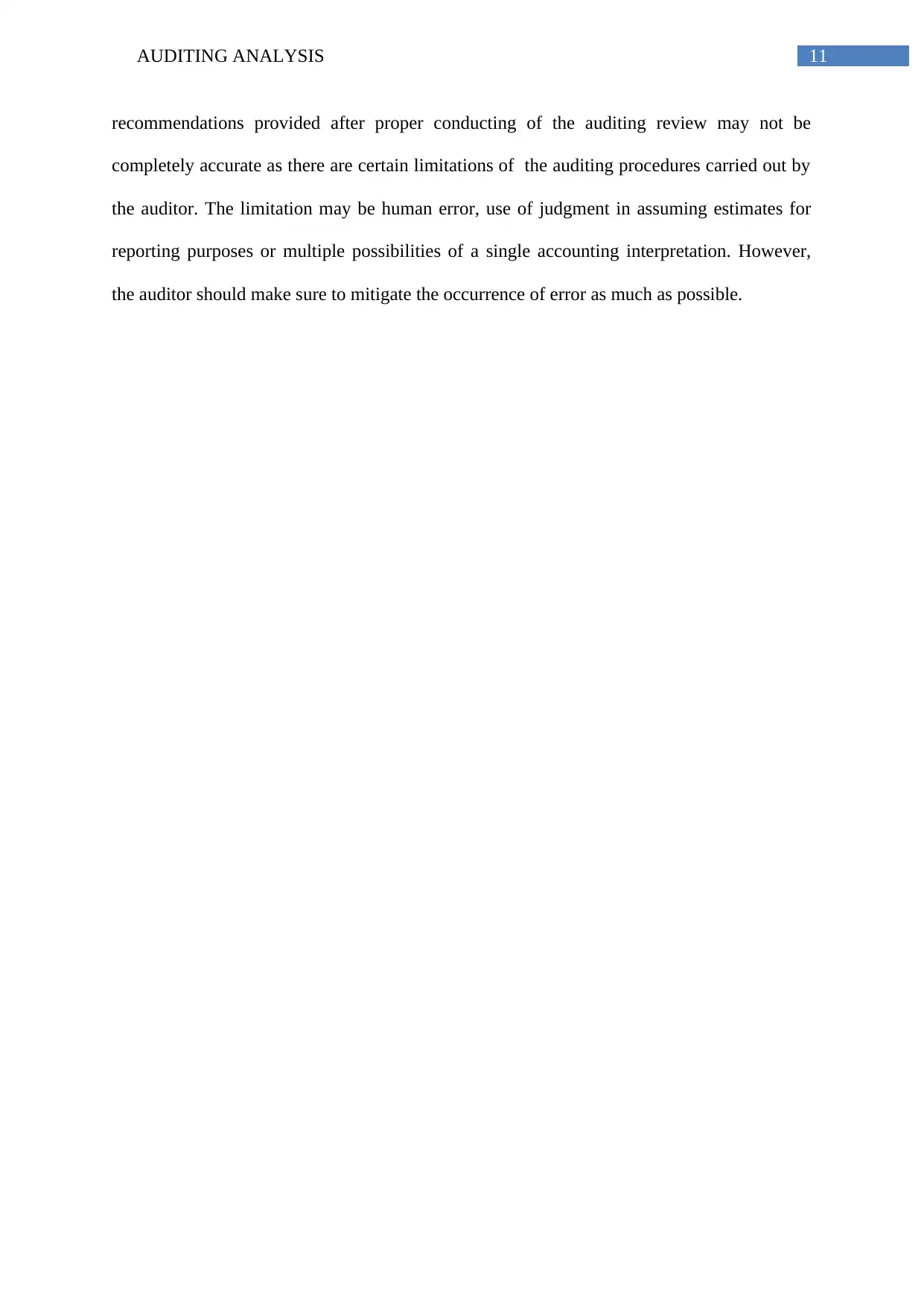
11AUDITING ANALYSIS
recommendations provided after proper conducting of the auditing review may not be
completely accurate as there are certain limitations of the auditing procedures carried out by
the auditor. The limitation may be human error, use of judgment in assuming estimates for
reporting purposes or multiple possibilities of a single accounting interpretation. However,
the auditor should make sure to mitigate the occurrence of error as much as possible.
recommendations provided after proper conducting of the auditing review may not be
completely accurate as there are certain limitations of the auditing procedures carried out by
the auditor. The limitation may be human error, use of judgment in assuming estimates for
reporting purposes or multiple possibilities of a single accounting interpretation. However,
the auditor should make sure to mitigate the occurrence of error as much as possible.
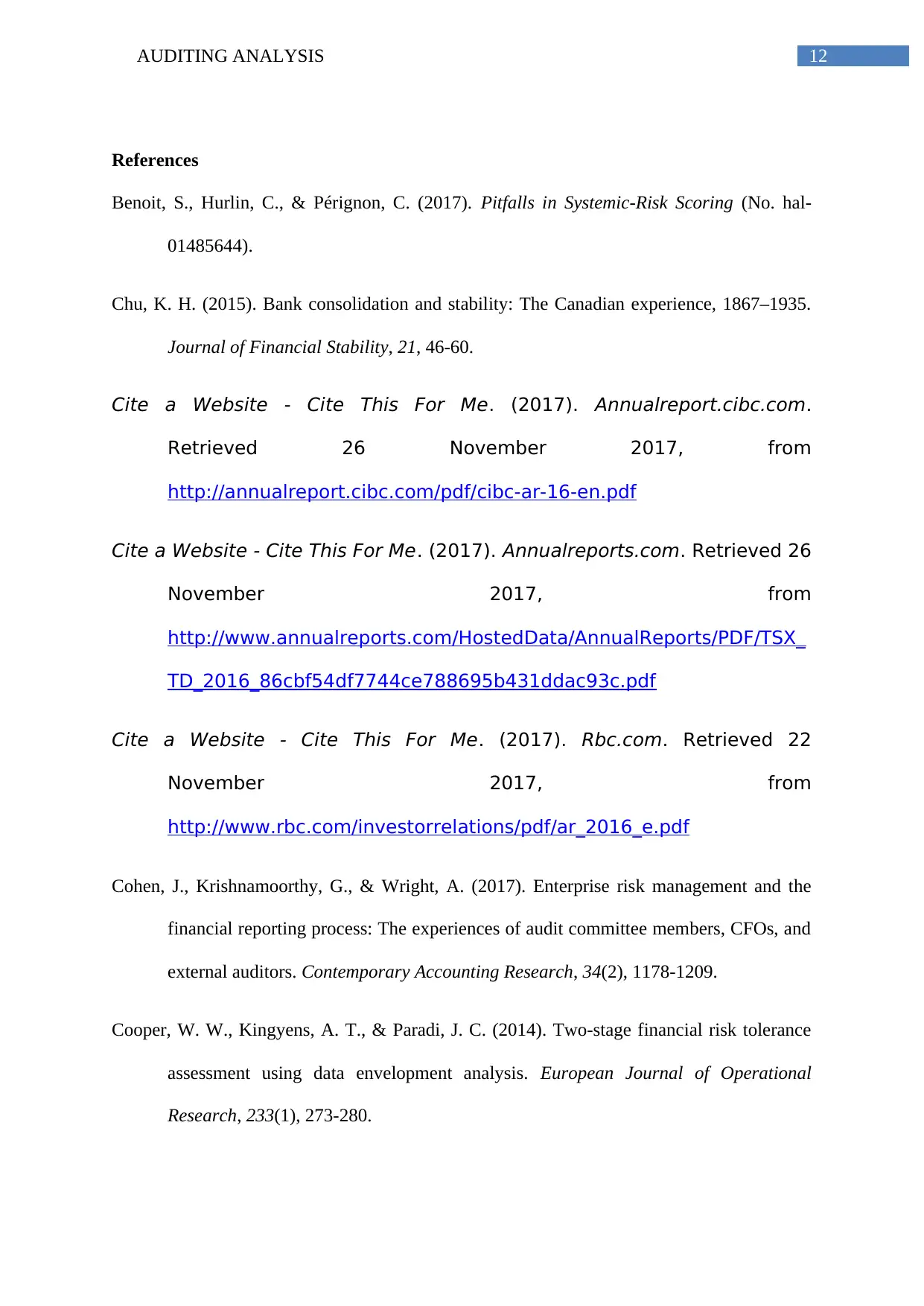
12AUDITING ANALYSIS
References
Benoit, S., Hurlin, C., & Pérignon, C. (2017). Pitfalls in Systemic-Risk Scoring (No. hal-
01485644).
Chu, K. H. (2015). Bank consolidation and stability: The Canadian experience, 1867–1935.
Journal of Financial Stability, 21, 46-60.
Cite a Website - Cite This For Me. (2017). Annualreport.cibc.com.
Retrieved 26 November 2017, from
http://annualreport.cibc.com/pdf/cibc-ar-16-en.pdf
Cite a Website - Cite This For Me. (2017). Annualreports.com. Retrieved 26
November 2017, from
http://www.annualreports.com/HostedData/AnnualReports/PDF/TSX_
TD_2016_86cbf54df7744ce788695b431ddac93c.pdf
Cite a Website - Cite This For Me. (2017). Rbc.com. Retrieved 22
November 2017, from
http://www.rbc.com/investorrelations/pdf/ar_2016_e.pdf
Cohen, J., Krishnamoorthy, G., & Wright, A. (2017). Enterprise risk management and the
financial reporting process: The experiences of audit committee members, CFOs, and
external auditors. Contemporary Accounting Research, 34(2), 1178-1209.
Cooper, W. W., Kingyens, A. T., & Paradi, J. C. (2014). Two-stage financial risk tolerance
assessment using data envelopment analysis. European Journal of Operational
Research, 233(1), 273-280.
References
Benoit, S., Hurlin, C., & Pérignon, C. (2017). Pitfalls in Systemic-Risk Scoring (No. hal-
01485644).
Chu, K. H. (2015). Bank consolidation and stability: The Canadian experience, 1867–1935.
Journal of Financial Stability, 21, 46-60.
Cite a Website - Cite This For Me. (2017). Annualreport.cibc.com.
Retrieved 26 November 2017, from
http://annualreport.cibc.com/pdf/cibc-ar-16-en.pdf
Cite a Website - Cite This For Me. (2017). Annualreports.com. Retrieved 26
November 2017, from
http://www.annualreports.com/HostedData/AnnualReports/PDF/TSX_
TD_2016_86cbf54df7744ce788695b431ddac93c.pdf
Cite a Website - Cite This For Me. (2017). Rbc.com. Retrieved 22
November 2017, from
http://www.rbc.com/investorrelations/pdf/ar_2016_e.pdf
Cohen, J., Krishnamoorthy, G., & Wright, A. (2017). Enterprise risk management and the
financial reporting process: The experiences of audit committee members, CFOs, and
external auditors. Contemporary Accounting Research, 34(2), 1178-1209.
Cooper, W. W., Kingyens, A. T., & Paradi, J. C. (2014). Two-stage financial risk tolerance
assessment using data envelopment analysis. European Journal of Operational
Research, 233(1), 273-280.
Paraphrase This Document
Need a fresh take? Get an instant paraphrase of this document with our AI Paraphraser
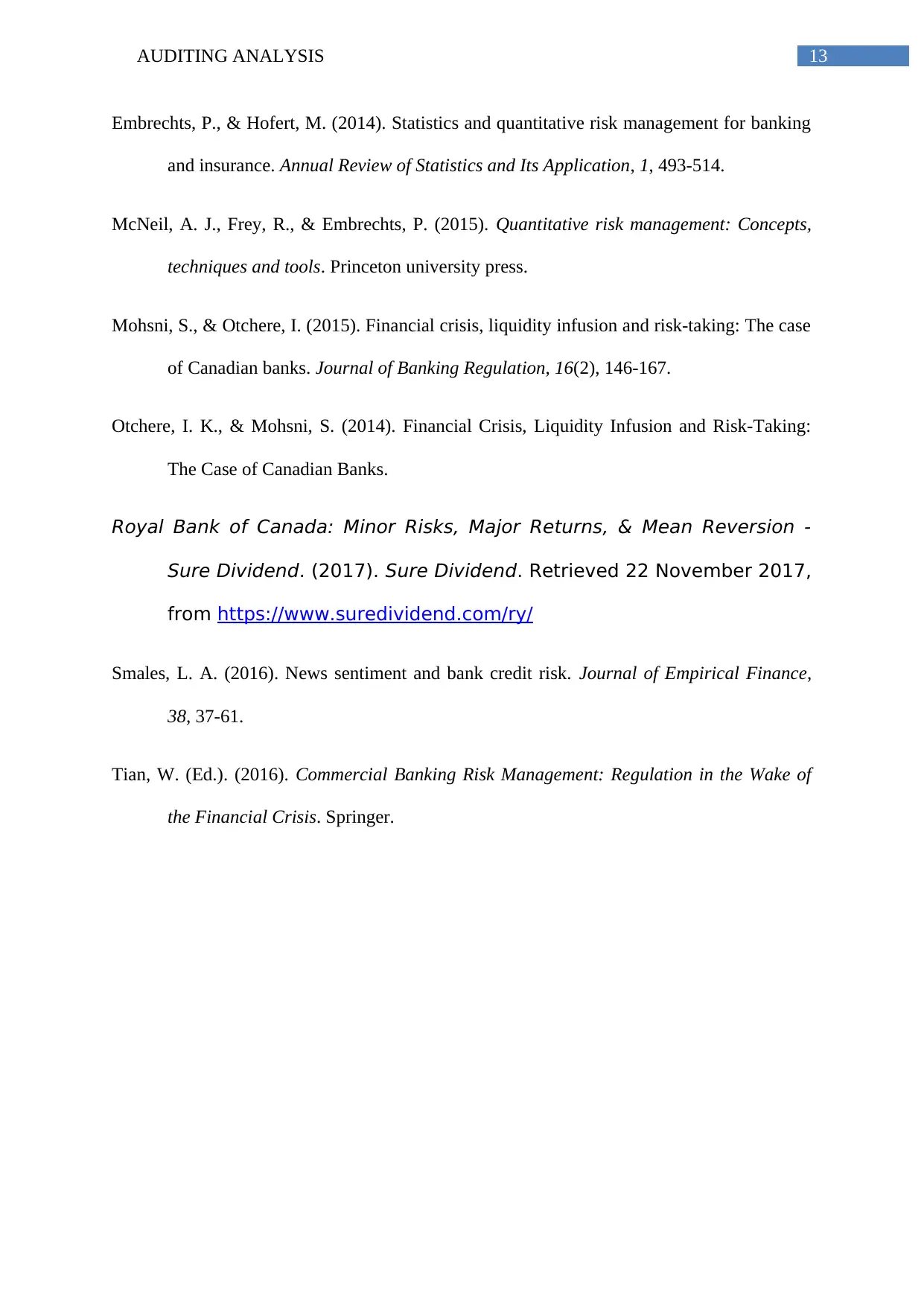
13AUDITING ANALYSIS
Embrechts, P., & Hofert, M. (2014). Statistics and quantitative risk management for banking
and insurance. Annual Review of Statistics and Its Application, 1, 493-514.
McNeil, A. J., Frey, R., & Embrechts, P. (2015). Quantitative risk management: Concepts,
techniques and tools. Princeton university press.
Mohsni, S., & Otchere, I. (2015). Financial crisis, liquidity infusion and risk-taking: The case
of Canadian banks. Journal of Banking Regulation, 16(2), 146-167.
Otchere, I. K., & Mohsni, S. (2014). Financial Crisis, Liquidity Infusion and Risk-Taking:
The Case of Canadian Banks.
Royal Bank of Canada: Minor Risks, Major Returns, & Mean Reversion -
Sure Dividend. (2017). Sure Dividend. Retrieved 22 November 2017,
from https://www.suredividend.com/ry/
Smales, L. A. (2016). News sentiment and bank credit risk. Journal of Empirical Finance,
38, 37-61.
Tian, W. (Ed.). (2016). Commercial Banking Risk Management: Regulation in the Wake of
the Financial Crisis. Springer.
Embrechts, P., & Hofert, M. (2014). Statistics and quantitative risk management for banking
and insurance. Annual Review of Statistics and Its Application, 1, 493-514.
McNeil, A. J., Frey, R., & Embrechts, P. (2015). Quantitative risk management: Concepts,
techniques and tools. Princeton university press.
Mohsni, S., & Otchere, I. (2015). Financial crisis, liquidity infusion and risk-taking: The case
of Canadian banks. Journal of Banking Regulation, 16(2), 146-167.
Otchere, I. K., & Mohsni, S. (2014). Financial Crisis, Liquidity Infusion and Risk-Taking:
The Case of Canadian Banks.
Royal Bank of Canada: Minor Risks, Major Returns, & Mean Reversion -
Sure Dividend. (2017). Sure Dividend. Retrieved 22 November 2017,
from https://www.suredividend.com/ry/
Smales, L. A. (2016). News sentiment and bank credit risk. Journal of Empirical Finance,
38, 37-61.
Tian, W. (Ed.). (2016). Commercial Banking Risk Management: Regulation in the Wake of
the Financial Crisis. Springer.
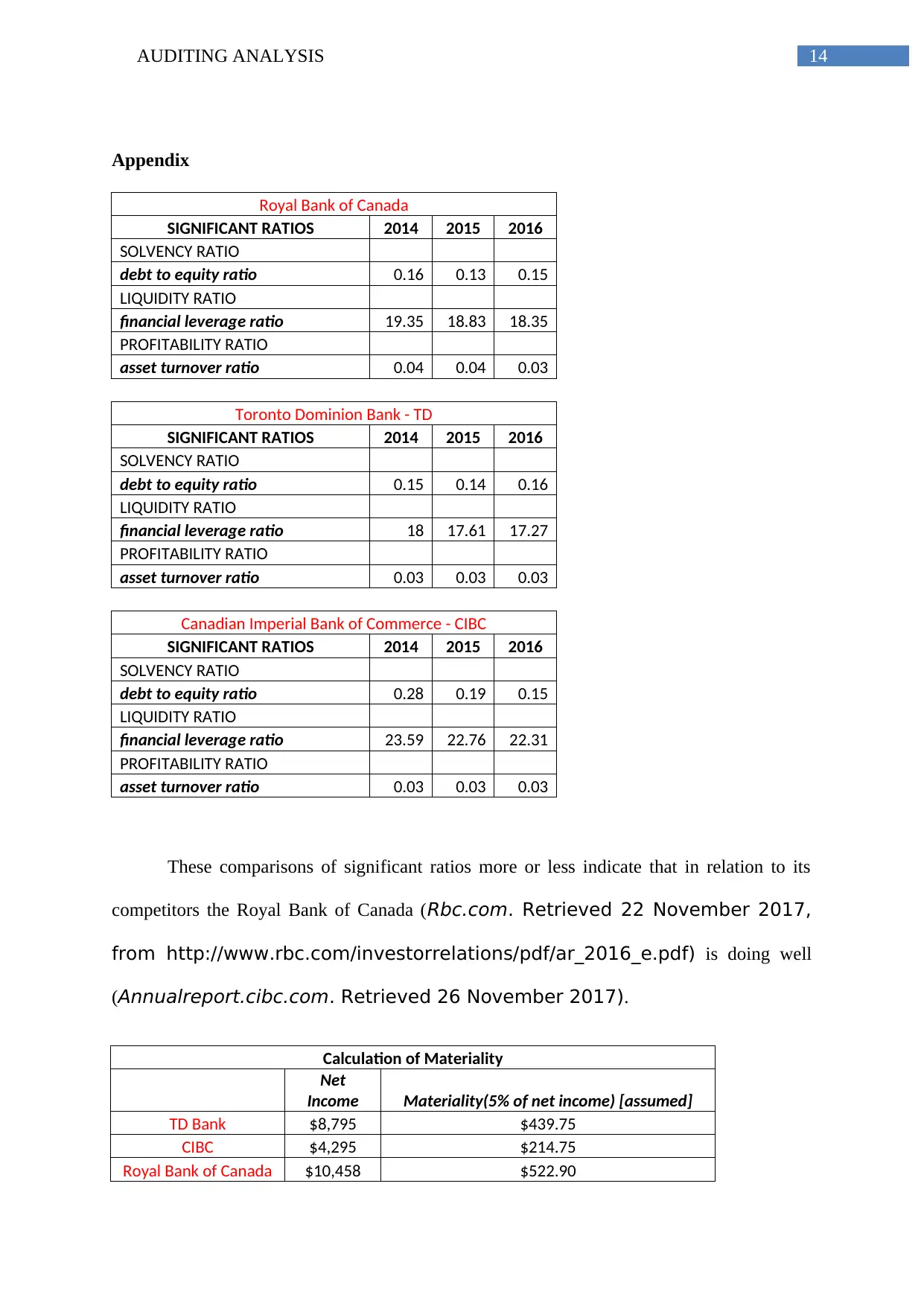
14AUDITING ANALYSIS
Appendix
Royal Bank of Canada
SIGNIFICANT RATIOS 2014 2015 2016
SOLVENCY RATIO
debt to equity ratio 0.16 0.13 0.15
LIQUIDITY RATIO
financial leverage ratio 19.35 18.83 18.35
PROFITABILITY RATIO
asset turnover ratio 0.04 0.04 0.03
Toronto Dominion Bank - TD
SIGNIFICANT RATIOS 2014 2015 2016
SOLVENCY RATIO
debt to equity ratio 0.15 0.14 0.16
LIQUIDITY RATIO
financial leverage ratio 18 17.61 17.27
PROFITABILITY RATIO
asset turnover ratio 0.03 0.03 0.03
Canadian Imperial Bank of Commerce - CIBC
SIGNIFICANT RATIOS 2014 2015 2016
SOLVENCY RATIO
debt to equity ratio 0.28 0.19 0.15
LIQUIDITY RATIO
financial leverage ratio 23.59 22.76 22.31
PROFITABILITY RATIO
asset turnover ratio 0.03 0.03 0.03
These comparisons of significant ratios more or less indicate that in relation to its
competitors the Royal Bank of Canada (Rbc.com. Retrieved 22 November 2017,
from http://www.rbc.com/investorrelations/pdf/ar_2016_e.pdf) is doing well
(Annualreport.cibc.com. Retrieved 26 November 2017).
Calculation of Materiality
Net
Income Materiality(5% of net income) [assumed]
TD Bank $8,795 $439.75
CIBC $4,295 $214.75
Royal Bank of Canada $10,458 $522.90
Appendix
Royal Bank of Canada
SIGNIFICANT RATIOS 2014 2015 2016
SOLVENCY RATIO
debt to equity ratio 0.16 0.13 0.15
LIQUIDITY RATIO
financial leverage ratio 19.35 18.83 18.35
PROFITABILITY RATIO
asset turnover ratio 0.04 0.04 0.03
Toronto Dominion Bank - TD
SIGNIFICANT RATIOS 2014 2015 2016
SOLVENCY RATIO
debt to equity ratio 0.15 0.14 0.16
LIQUIDITY RATIO
financial leverage ratio 18 17.61 17.27
PROFITABILITY RATIO
asset turnover ratio 0.03 0.03 0.03
Canadian Imperial Bank of Commerce - CIBC
SIGNIFICANT RATIOS 2014 2015 2016
SOLVENCY RATIO
debt to equity ratio 0.28 0.19 0.15
LIQUIDITY RATIO
financial leverage ratio 23.59 22.76 22.31
PROFITABILITY RATIO
asset turnover ratio 0.03 0.03 0.03
These comparisons of significant ratios more or less indicate that in relation to its
competitors the Royal Bank of Canada (Rbc.com. Retrieved 22 November 2017,
from http://www.rbc.com/investorrelations/pdf/ar_2016_e.pdf) is doing well
(Annualreport.cibc.com. Retrieved 26 November 2017).
Calculation of Materiality
Net
Income Materiality(5% of net income) [assumed]
TD Bank $8,795 $439.75
CIBC $4,295 $214.75
Royal Bank of Canada $10,458 $522.90
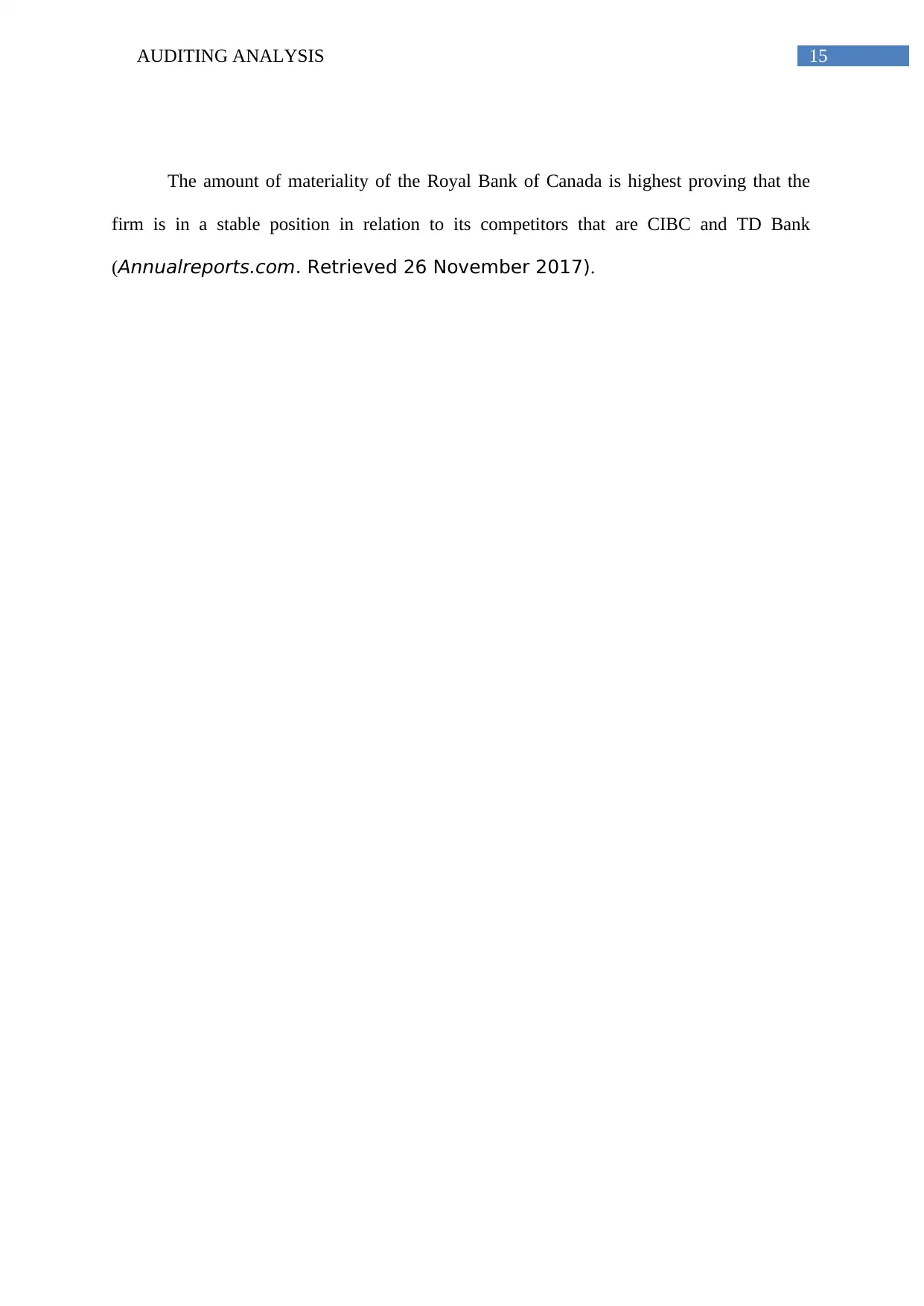
15AUDITING ANALYSIS
The amount of materiality of the Royal Bank of Canada is highest proving that the
firm is in a stable position in relation to its competitors that are CIBC and TD Bank
(Annualreports.com. Retrieved 26 November 2017).
The amount of materiality of the Royal Bank of Canada is highest proving that the
firm is in a stable position in relation to its competitors that are CIBC and TD Bank
(Annualreports.com. Retrieved 26 November 2017).
1 out of 16
Related Documents
Your All-in-One AI-Powered Toolkit for Academic Success.
+13062052269
info@desklib.com
Available 24*7 on WhatsApp / Email
![[object Object]](/_next/static/media/star-bottom.7253800d.svg)
Unlock your academic potential
© 2024 | Zucol Services PVT LTD | All rights reserved.





